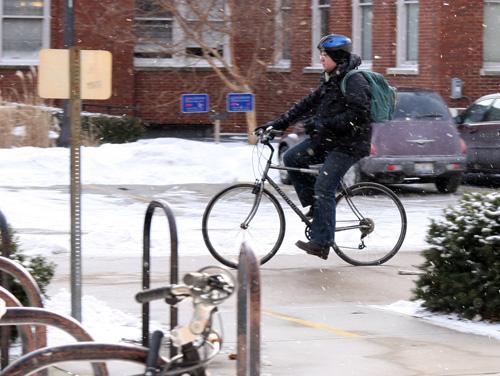Cold-weather dangers keep bicyclists on their toes

Undeterred by the weather, a biker travels along a sidewalk between Altgeld Hall and the Henry Administration Building on Tuesday afternoon. Erica Magda
February 6, 2009
Bike safety on campus is already an issue, and snow and ice complicate it further.
Most people who ride bikes on campus elect to lock them up during the winter, but some students and community members continue riding through the colder months. Streets and sidewalks are not always clear of snow and ice, even if they appear to be, which means riders face even more dangers when temperatures drop.
“You never know where the dangerous places are going to be, but heavy traffic areas are high-risk areas,” said Lt. Skip Frost, head of the patrol division of the University Police Department. “It’s just one of those things where it pays to stay on your toes.”
Despite the obstacles caused by snow piles and icy spots, some riders still think biking is more time-efficient.
“Having a bike gets me to class a lot faster,” said Josh Baker, senior in LAS. “It’s a lot better than walking to class when it’s cold.”
Get The Daily Illini in your inbox!
It is general practice for bicyclists riding on the road to try to stay as far to the right as possible. When snow and ice build up on the sides of the streets, bicyclists aren’t able to keep as close to the side, Frost said.
“If the ice is too bad I don’t take my bike,” Baker said, “But if it’s not too bad I just bundle up and go.”
Frost attributed occasionally incomplete snow and ice removal to the magnitude of the task; clearing 1 inch of snow is much less work than clearing 2, 4 or 6 inches.
“Our first priority is safety,” said Morgan Johnston, the transportation demand management coordinator for Facilities and Services. “Removal of snow is considered priority work, day or night, regardless of accumulation.”
She said part of the job is the responsibility of the city.
“The University only owns so many of the roads such as Gregory Drive, part of Armory and South First Street,” Frost said, “We are at the mercy of the city as far as their streets are concerned.”
Johnston said the streets are cleared with cooperation between the University and the city with both sides helping each other based on the situation.
Frost said that if students are going to ride bikes during the winter, they should invest in all-terrain bicycles that add stability and be sure to wear a helmet. He said it is important for students to remember all the rules of the road that are followed during any other season.






